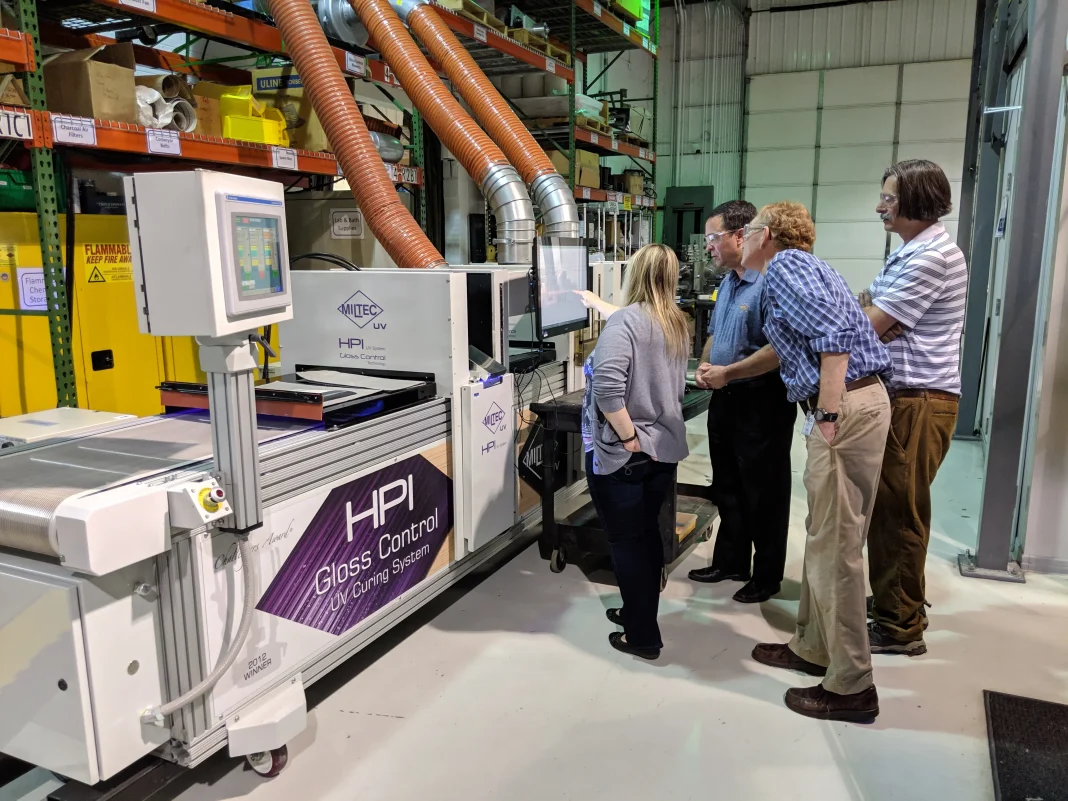By Mike J. Idacavage, PhD, Technical Marketing Adviser, and John Arnold, PhD, Director of Research and Development, Miltec UV
Introduction
Many commercial sheet-fed litho printing presses that are used to print on flat steel sheets for the can industry, or on paper or plastic sheets, utilize traditional UV arc lamps that are cooled by a combination of water and air to help prevent overheating critical press parts. These UV lamps are placed after each printing station or deck and will cure each ink color after it is printed. These presses have very little space for the lamp; as a result, the lamps can become cumbersome to maintain, generate a lot of heat – which can damage the press – and typically have short lamp and reflector life since they are not adequately cooled due to poor air flow. Since these presses have a tight space constraint in which to mount a lamp, it can limit which type of lamp can be used. Therefore, microwave lamps are almost never used since they are too large. However, after the sheet is printed, there almost always is a set of lamps to complete the curing on a conveyor. In this case, any lamp type could be used to complete the ink cure. This paper will explore a comparison of lamp types to use for inter-deck ink curing and final ink curing. It is part of a larger study on various lamp, ink and varnish combinations. The three lamp systems chosen are the high-powered arc lamp, microwave lamp and UV LED multi-wavelength lamp system.
UV source/Chemistry background
Three major categories of UV sources are commonly used in industry: arc, microwave and UV LED lamps. In addition, UV LED lamps can be further divided into single wavelength and multi-wavelength lamps. Each UV source has its advantages, as shown in Tables 1-3.
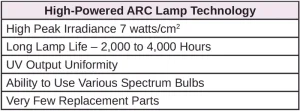

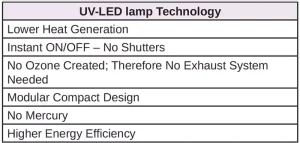
To a company seeking to either convert to a UV-curable system on a can coating line or simply to upgrade an older system, these advantages all look attractive, and there is no obvious winner amongst the three UV source contenders.
There also is the question of the proper formulated ink and varnish to be coated. A wide variety of ink and varnishes are formulated specifically for broadband energy sources, such as arc or microwave and UV LED formulated varnishes. This could get complicated for the converter in the case that the plant uses multiple sources that might require different formulated inks and varnishes. While the experimental program that was run covered a range of different UV sources and formulations, this paper will focus on one aspect of the overall evaluation. Specifically, we will be looking at the use of a range of different lamps to cure Hg lamp-formulated ink, followed by either an Hg lamp or UV LED-formulated clear varnish.
Experimental conditions
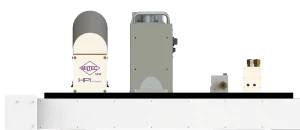
The coating line was set up as shown in Figure 1. The UV lamps used in the evaluation are the Miltec UV HPI™ 23″ Arc Lamp UV System, Miltec UV Xtrema Plus™ Microwave Powered UV System, Miltec UV 385nm UV LED and a Miltec UV LED Multi-spectrum UV. The black UV-curable ink was obtained from Sun Chemical. The UV broadband-curable varnishes were obtained from Watson Standard, while the UV LED-formulated clear varnishes were obtained from UVitec. Ink application was done per the supplier recommendation for each ink type, using a Little Joe Proofing Press. All clear varnishes were applied via drawdown. The Watson Standard 971-0452-L varnish was applied at the standard film weight of 22 to 26 mg per sq.in. The UVitec UV LED varnish was applied at a film weight of 22 to 26 mg per sq.in.
Results
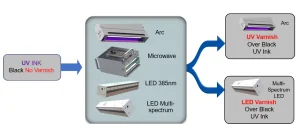
The experimental plan is illustrated in Figure 2.
The UV Hg bulb-formulated black ink was cured by one of the four UV sources. This then was followed by coating a UV Hg bulb or a UV LED-formulated clear varnish over the ink and then curing the coated sample with either a UV arc lamp or multi-spectrum UV LED.
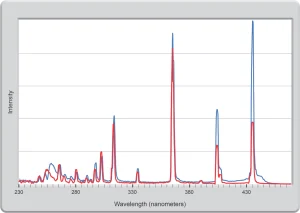
Both arc and microwave lamps have targeted bulbs – such as “H,” “D,” etc. – that are assumed to emit similar spectra. For the purposes of this study, several commonly used bulbs that are available for both systems were evaluated, and their spectra compared. Figure 3 illustrates the “H” bulb spectra for both an arc and microwave system. The individual peaks are almost an exact match. This indicates that a suitable coating formulation can be exchanged between the two systems with similar results if the power output is similar between the lamps. Other metal halide additive bulbs, such as the “D” bulb, also were examined and were shown to be nearly identical.
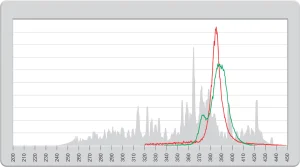
As expected, there is a dramatic difference in emitted wavelengths when an arc “D” bulb is compared to either a single wavelength or multi-spectra UV LED lamp. This is shown in Figure 4.
However, there is enough overlap of emitted wavelengths to suggest that a multi-spectrum UV LED may serve as a substitute for an Hg “D” bulb.

Table 4 lists the results for an Hg bulb-formulated black ink and a UV LED-formulated clear varnish. The first column records the type of lamp used to cure the ink while the following two columns – Thumb Twist and Adhesion – demonstrate that all four types of lamps can be used to cure this ink. The remaining columns show the results after the clear varnish has been cured using a multi-spectrum UV LED lamp. Except for the microwave lamp, all combinations gave acceptable results. The X in Table 4 signifies unknown results. Depending on the application, the sheen values may or may not be acceptable. As the UV LED varnish used was a commercially available product, its typical use may not be for a high-sheen application.

Table 5 shows the data for an Hg bulb-formulated black ink and an Hg bulb-formulated clear varnish cured using an arc lamp. The columns are the same as shown in Table 4. All ink cured combinations were successful when combined with a final Hg lamp cure of the varnish.
While the purpose of the study reported in this paper was to determine if a UV LED lamp can be used as an inter-deck curing unit in a metal can coating line, along with a determination of which type of formulations can be used, it was noted in many other experimental runs that it is important to align the photoinitiator absorbance with the emitted UV spectrum. This is a far more important factor than whether a formulation is listed as a UV LED formulation or an Hg lamp formulation.
Summary
This series of experiments evaluated different combinations of UV lamps and lamp-specific formulated inks and varnishes for metal can packaging. It was found that high-powered arc or multi-spectral UV LED lamps were excellent for inter-deck UV and UV LED ink curing due to their ability to cure and their physical size – especially when enhanced by a high-powered arc lamp to cure the varnish. As expected, there must be proper alignment between the chemistry of the ink and varnish along with the systems.
Acknowledgement
The authors would like to acknowledge the significant contribution that Renee Muloski, Crown Technology, made to the design and execution of the overall experimental program. In addition, the authors would like to thank Beth Mosner, Miltec UV, for her key role in coordinating the experimental program and her substantial input in developing this article.



